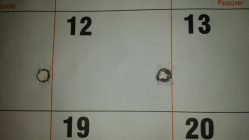You are using an out of date browser. It may not display this or other websites correctly.
You should upgrade or use an alternative browser.
You should upgrade or use an alternative browser.
Are We Doing Load Development Wrong?
- Thread starter Jud96
- Start date
Nice shooting no doubt.Here's two, yes. 5 shot groups at 100. I don't keep up with this kinda thing much any more but I do promise these were both on the same day, back to back 5 shot groups at 100 and the wind had to blow them in, because conditions were good but not great.
View attachment 1396754
Thank you, and nope, can't do it every time but those two groups were part of a 100 round test done in one day without sighters. 20.....5 shot groups agged a .173 or .175. That was in about 2017ish. I'd buy all that lot of bullets he'd make me, for sure. Shoulda saved em but ya can't stop when things are going like that. I've got a few more pics of the same target, fired on an old desk calendar. Yes, that's outside to outside minus .308,Nice shooting no doubt.
(30 Major) so it wouldn't have officially measured quite that small but both of those were under bullet diameter. I'd say it was tuned up regardless....almost. Lol!
Last edited:
But we're doing it wrong, remember!LOL. Take your pic. It will be interesting for sure.
Yea I know right . But, hey we gotta start somewhere.
This thread got me thinking about assumptions I make and I decided to test it a little today. I took my stock Ruger precision rifle in 6.5 creedmoor, I opened a book and picked a load for H380, a powder I have on the shelf but haven’t used in this rifle. Used a powder throw, hornady cases with no prep, and seated 147elds to magazine length. Basically what Id expect an average shooter to do.
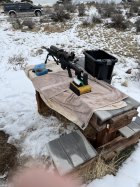
Went to 100yards and I shot 10 rounds into a group to warm up the barrel and foul everything in. I then shot 3 groups round robin, one with 3 shots, one with 5 shots, and one with 10 shots total. I then took the rest of my rounds and shot a 3, 4, and 5 shot group. I did this with 5 flags along the range to help guide me. Here’s what it looks like:
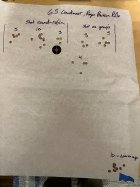
The question I was asking is if additional shots gave me additional info that is useful for evaluating this random load I chose. I don’t think so.

Went to 100yards and I shot 10 rounds into a group to warm up the barrel and foul everything in. I then shot 3 groups round robin, one with 3 shots, one with 5 shots, and one with 10 shots total. I then took the rest of my rounds and shot a 3, 4, and 5 shot group. I did this with 5 flags along the range to help guide me. Here’s what it looks like:

The question I was asking is if additional shots gave me additional info that is useful for evaluating this random load I chose. I don’t think so.
Keith Glasscock
Gold $$ Contributor
And that, my friends, qualifies as a statistically significant test!Thank you, and nope, can't do it every time but those two groups were part of a 100 round test done in one day without sighters. 20.....5 shot groups agged a .173 or .175. That was in about 2017ish. I'd buy all that lot of bullets he'd make me, for sure. Shoulda saved em but ya can't stop when things are going like that. I've got a few more pics of the same target, fired on an old desk calendar. Yes, that's outside to outside minus .308,
(30 Major) so it wouldn't have officially measured quite that small but both of those were under bullet diameter. I'd say it was tuned up regardless....almost. Lol!
Keith Glasscock
Gold $$ Contributor
Given the 5 shot groups are roughly twice the size of the 3 shot groups, and the 10 shot group is about 60% bigger than the 5 shot group (all visually estimated - I could be off by a LOT!), I think you actually proved the point. If that were and F-Open rifle, I would have given up after the 3 shot group.This thread got me thinking about assumptions I make and I decided to test it a little today. I took my stock Ruger precision rifle in 6.5 creedmoor, I opened a book and picked a load for H380, a powder I have on the shelf but haven’t used in this rifle. Used a powder throw, hornady cases with no prep, and seated 147elds to magazine length. Basically what Id expect an average shooter to do.
View attachment 1396756
Went to 100yards and I shot 10 rounds into a group to warm up the barrel and foul everything in. I then shot 3 groups round robin, one with 3 shots, one with 5 shots, and one with 10 shots total. I then took the rest of my rounds and shot a 3, 4, and 5 shot group. I did this with 5 flags along the range to help guide me. Here’s what it looks like:
View attachment 1396757
The question I was asking is if additional shots gave me additional info that is useful for evaluating this random load I chose. I don’t think so.
Let me state for the record that I do not load develop looking for the best load, as that is statistically impossible without involving luck. Instead, I load develop to eliminate load combinations that do not meet my requirements. After that, I try to pick the best combination of what remains (which is usually in one blob of a wide node).
When I think about it, I guess I do look for the best combination for my use, I just go about it like a game of survivor... Off the island with you!
i’m more than happy to make monetary donations to see something like this actually happenThat's a heck of an idea! Let's build a rifle, break it in, and give each of them say 200 rounds worth of barrel time to do load development with our supplied primers, cases, bullets and powder. ( We would have to alternate shooting for fairness).
From that, they would each produce 200 rounds of their optimal load, and we shoot the two loads against each other head to head.
Better yet, we use a caliber that neither is familiar with in a rail gun. Now, if we just had a warehouse...
We could turn that into a competitive event. Who's Tune is Better Anyway?
Please ignore the seemingly mild sarcasm. I'm truly interested in seeing that.
I think we’re on the same page and I agree with your approach. I wouldn’t choose a load based on the single smallest group I shot with it and I believe the shape is more important than the measured size, which is why I don’t think additional shots gave me new or better information.Given the 5 shot groups are roughly twice the size of the 3 shot groups, and the 10 shot group is about 60% bigger than the 5 shot group (all visually estimated - I could be off by a LOT!), I think you actually proved the point. If that were and F-Open rifle, I would have given up after the 3 shot group.
Let me state for the record that I do not load develop looking for the best load, as that is statistically impossible without involving luck. Instead, I load develop to eliminate load combinations that do not meet my requirements. After that, I try to pick the best combination of what remains (which is usually in one blob of a wide node).
When I think about it, I guess I do look for the best combination for my use, I just go about it like a game of survivor... Off the island with you!
I didn’t do the math, but my eyeball says that 10 shots has the same weighted center of group as 5 and 3 shots, and the 3 shot group already shows a tendency to drop shots out the bottom of the group, which got worse as I added more shots.
First, there were three of them, in the podcast, not two, so anything else you might have to say is now suspect with me, as your counting skills may be somewhat lacking.The point these two in the video are trying to get across is completely over the head of so many if not most people commenting in this thread.
It's not really applicable to benchrest because you're changing your load all the time.
This video is primarily for the hunter and PRS type competitor.
- shooting 3-5 shot groups will not tell you the true zero of the load you're shooting (load that is not changed)
- you don't shoot a 20-30 shot string. It's a total of that many at the same POA to have high confidence in the zero. If you say you only care about those first 3 shots on cold clean bore, then repeat that 10
- you have to take into account the shooter and the gun as a system, no shot exclusions unless you're 100% sure you yanked it
- having 95% confidence of your zero by shooting 30 shots to same POA will help prevent chasing your tail when verifying velocity and drops
- making minor changes in powder charge and seating depth will not make a noticeable difference to the shooter who their message is going to, at least with the powders and bullets they've tested.
Second, thanks so much for your vote of confidence on the intelligence of "so many if not most" of the readership here at Accurate Shooter. In your defense, you did not state that any Neanderthals were included in that list and I for one appreciate that, as I may or may not have been accused of such a title on occasion. It's gotta be lonely at the top, eh?
Third, how do YOU know who the video was intended for? Are you an insider? Are you actually The Third Man (see "First", above)? Perhaps you have some sort of e-telepathy that allows you insight across the youtube platform. If so, that is a marketable skill right there and you should take immediate advantage of it. Perhaps you already are and it's just way over my head. Either way, had I known of this skill before watching the podcast, I could have saved myself the time, as I am neither much of a hunter or a PRS competitor (those poor, misguided souls).
OK, enough of this. My apologies if this sounded a bit trite. Perhaps more coffee is needed.
Happy New Year, sir. Hopefully it will improve over last year. On a positive note, I will say that I haven't shot a bad group so far this year..........
dcali
Bullet Maker
That's nonsense. If your rifle shoots that poorly, you really shouldn't be shooting very far. A decent rifle can verify a zero with 2-3 shots to the required precision.The point these two in the video are trying to get across is completely over the head of so many if not most people commenting in this thread.
It's not really applicable to benchrest because you're changing your load all the time.
This video is primarily for the hunter and PRS type competitor.
- shooting 3-5 shot groups will not tell you the true zero of the load you're shooting (load that is not changed)
- you don't shoot a 20-30 shot string. It's a total of that many at the same POA to have high confidence in the zero. If you say you only care about those first 3 shots on cold clean bore, then repeat that 10
- you have to take into account the shooter and the gun as a system, no shot exclusions unless you're 100% sure you yanked it
- having 95% confidence of your zero by shooting 30 shots to same POA will help prevent chasing your tail when verifying velocity and drops
- making minor changes in powder charge and seating depth will not make a noticeable difference to the shooter who their message is going to, at least with the powders and bullets they've tested.
Gentlemen I find the videos provided by Hornady interesting and I hope we can remain gentlemen while we discuss them. I believe these videos provide insight and I know when me and my loading associates get together we (may) have one too many, smoke some cigars and discuss them while we solve the problem of peace in the Middle Eastl
I disagree, as a range master for over a decade I'll explain my reasoning.That's nonsense. If your rifle shoots that poorly, you really shouldn't be shooting very far. A decent rifle can verify a zero with 2-3 shots to the required precision.
From experience a shooter come to the range and zeros their rifle. The end result is nice about a 3/4" cold bore group.
One prints 3/8" off center axis at 2 o'clock, one prints 1/4" off axis directly at 3 o'clock and the last one prints 5/16" off axis at 9 o'clock. Cold bore.
The next time the 3/4" groups prints differently. It's still a 3/4" group but the first one now hits 5/8" off axis at 7 o'clock, the second hits 1/16" low at 6 o'clock the last one at 8 o'clock 13/16" off axis. Cold bore.
Repeat this 10 times with Cold bore groups and the center of the combined groups will appear.
dcali
Bullet Maker
That’s true but the difference doesn’t matter ballistically. A cold bore usually sorts itself out in a couple shots and after that, a couple more will confirm your zero well enough.I disagree, as a range master for over a decade I'll explain my reasoning.
From experience a shooter come to the range and zeros their rifle. The end result is nice about a 3/4" cold bore group.
One prints 3/8" off center axis at 2 o'clock, one prints 1/4" off axis directly at 3 o'clock and the last one prints 5/16" off axis at 9 o'clock. Cold bore.
The next time the 3/4" groups prints differently. It's still a 3/4" group but the first one now hits 5/8" off axis at 7 o'clock, the second hits 1/16" low at 6 o'clock the last one at 8 o'clock 13/16" off axis. Cold bore.
Repeat this 10 times with Cold bore groups and the center of the combined groups will appear.
If your talking a hunting rifle in my opinion the last thing you want is the cold bore to sort itself out. The process Hornady tested sorts out the zeromto the cold bore.That’s true but the difference doesn’t matter ballistically. A cold bore usually sorts itself out in a couple shots and after that, a couple more will confirm your zero well enough.
I've actually done this for decades with sporterized military rifles. Shoot multiple 3 shot cold bore groups all to the center axis aim point. Superimpose them and find the center, in general the combined groups will be 2 to 3 times the size of a single group, the center of those groups will not be the center axis of your target. Adjust your sight to bring the proven center of impact to the axis of the target and you'll improve your chances of a 1 shot hit.
The reality is this, barring damage to the rifle or sighting system you can get by with one major sight in session. You can load all you can with the same lot powder and bullets and shoot for years. Just shoot a few to check against you composite graph. My sister in law, me and several others have done so for decades.Since when did “well enough” cut the mustard around here?
Jager
Gold $$ Contributor
Okay, Bryan's book arrived in the mail yesterday. And I've watched both of the Hornady Podcast episodes that, together with Bryan's book, were apparently what prompted the question posed by the OP - are we doing load development wrong?
https://www.midwayusa.com/product/1025651255?pid=287017
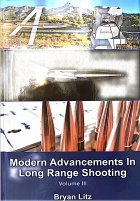
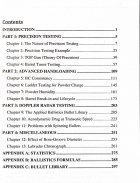
I have to confess I had never watched the Hornady Podcast before. At just over an hour for each episode, it's not a trivial investment in time. But Seth, Miles, and Jayden are all obviously thoughtful, intelligent, and articulate gentlemen. They present themselves exceptionally well. I enjoyed their discussions enough that I subscribed to their channel.
I'm a fan of Bryan Litz. He usually brings a rigorous, thoughtful, facts-oriented focus to his shooting-sports research. This is the fourth book of his I've purchased.
When I opened this latest effort by him and saw that Chapter 6: Ladder Testing for Powder Charge I thought "okay, here's where all the hullabaloo came from."
But having now watched both of those podcasts, and read portions of the book, it's clear to me that there's more than a little bit of "horses for courses," as the old saying goes. It's not that they're wrong, as far as it goes.
But although "benchrest" is mentioned in passing a few times, it seems clear to me that although they thought they were covering the field, the truth is none of them appear to actually have any direct experience with the most accurate rifles out there.
At the end of the second podcast, Seth turns to Miles and asks him to explain his load development methodology. And, indeed, it's kind of a stunner to hear Miles so cavalierly dismiss charge weight and seating depth. I suppose if you've never deliberately run your bullet into the lands, because barrel after barrel and rifle after rifle has told you that that's where they shoot best... it's just not a thing you're going to think is important.
But it's when Miles talks about ".75 MOA, maybe .8" as his yardstick when developing a load that you know that what he's doing, and what he's looking for, is a world away from what a benchrest competitor is seeking.
Bryan's chapter on ladder testing was also a disappointment. Not because it was wrong - it wasn't. But because it focused solely on charge weight testing to determine if the muzzle velocity "flat spots" that frequently occur across a ladder are repeatable (spoiler: they're not).
As someone who has never believed in that thesis, it wasn't the kind of test I found interesting or insightful. But if you're one of those who look to your chronograph to tell you where you're good loads are, instead of the target downrange... I suppose that might qualify as big news.
The larger point raised by both Litz and the Hornady team about sample sizes and dispersion and how shooting larger groups inevitably leads to greater dispersion... until that time that you've put enough shots downrange that you have a normal distribution... is not something I disagree with, either.
But if Bryan and Seth and Miles and Jayden were to attend a SR Score Benchrest match they'd observe the winner touching that tiny little X twenty-some times, out of 25 record shots. Even with conditions. And the two or three shots that missed... missed by a hair.
Close behind that winner would be several other competitors, just an X or two down.
And if Bryan and Seth and Miles and Jayden choose to go to several matches, in different places, they'll continue to see those same top shooters atop the leaderboard.
It's not luck.
But you know what? You take those 25-shots for record at each match and you add 'em together - same relative POA, save only adjusting for conditions - and you've got your normal distribution.
The bottom line for me is that when we're talking about the best, most accurate rifles in the world, we're talking about a world where nuance matters. A world where the tiny change in barrel harmonics that a tuner provides, or that a seating depth change effects, can absolutely be seen on the target.
It doesn't surprise me that someone who has never experienced that world, might think those don't matter.
https://www.midwayusa.com/product/1025651255?pid=287017


I have to confess I had never watched the Hornady Podcast before. At just over an hour for each episode, it's not a trivial investment in time. But Seth, Miles, and Jayden are all obviously thoughtful, intelligent, and articulate gentlemen. They present themselves exceptionally well. I enjoyed their discussions enough that I subscribed to their channel.
I'm a fan of Bryan Litz. He usually brings a rigorous, thoughtful, facts-oriented focus to his shooting-sports research. This is the fourth book of his I've purchased.
When I opened this latest effort by him and saw that Chapter 6: Ladder Testing for Powder Charge I thought "okay, here's where all the hullabaloo came from."
But having now watched both of those podcasts, and read portions of the book, it's clear to me that there's more than a little bit of "horses for courses," as the old saying goes. It's not that they're wrong, as far as it goes.
But although "benchrest" is mentioned in passing a few times, it seems clear to me that although they thought they were covering the field, the truth is none of them appear to actually have any direct experience with the most accurate rifles out there.
At the end of the second podcast, Seth turns to Miles and asks him to explain his load development methodology. And, indeed, it's kind of a stunner to hear Miles so cavalierly dismiss charge weight and seating depth. I suppose if you've never deliberately run your bullet into the lands, because barrel after barrel and rifle after rifle has told you that that's where they shoot best... it's just not a thing you're going to think is important.
But it's when Miles talks about ".75 MOA, maybe .8" as his yardstick when developing a load that you know that what he's doing, and what he's looking for, is a world away from what a benchrest competitor is seeking.
Bryan's chapter on ladder testing was also a disappointment. Not because it was wrong - it wasn't. But because it focused solely on charge weight testing to determine if the muzzle velocity "flat spots" that frequently occur across a ladder are repeatable (spoiler: they're not).
As someone who has never believed in that thesis, it wasn't the kind of test I found interesting or insightful. But if you're one of those who look to your chronograph to tell you where you're good loads are, instead of the target downrange... I suppose that might qualify as big news.
The larger point raised by both Litz and the Hornady team about sample sizes and dispersion and how shooting larger groups inevitably leads to greater dispersion... until that time that you've put enough shots downrange that you have a normal distribution... is not something I disagree with, either.
But if Bryan and Seth and Miles and Jayden were to attend a SR Score Benchrest match they'd observe the winner touching that tiny little X twenty-some times, out of 25 record shots. Even with conditions. And the two or three shots that missed... missed by a hair.
Close behind that winner would be several other competitors, just an X or two down.
And if Bryan and Seth and Miles and Jayden choose to go to several matches, in different places, they'll continue to see those same top shooters atop the leaderboard.
It's not luck.
But you know what? You take those 25-shots for record at each match and you add 'em together - same relative POA, save only adjusting for conditions - and you've got your normal distribution.
The bottom line for me is that when we're talking about the best, most accurate rifles in the world, we're talking about a world where nuance matters. A world where the tiny change in barrel harmonics that a tuner provides, or that a seating depth change effects, can absolutely be seen on the target.
It doesn't surprise me that someone who has never experienced that world, might think those don't matter.
Similar threads
- Replies
- 61
- Views
- 14,505
- Replies
- 18
- Views
- 2,393
Upgrades & Donations
This Forum's expenses are primarily paid by member contributions. You can upgrade your Forum membership in seconds. Gold and Silver members get unlimited FREE classifieds for one year. Gold members can upload custom avatars.

Click Upgrade Membership Button ABOVE to get Gold or Silver Status.
You can also donate any amount, large or small, with the button below. Include your Forum Name in the PayPal Notes field.
To DONATE by CHECK, or make a recurring donation, CLICK HERE to learn how.

Click Upgrade Membership Button ABOVE to get Gold or Silver Status.
You can also donate any amount, large or small, with the button below. Include your Forum Name in the PayPal Notes field.
To DONATE by CHECK, or make a recurring donation, CLICK HERE to learn how.










